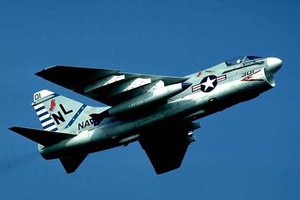A-7 Corsair II
|
|
The Ling-Temco-Vought A-7 Corsair II was a light attack aircraft based on the F-8 Crusader. It served with both the United States Navy and the United States Air Force, and later with the Air National Guard. It was also exported to Greece, Portugal, and Thailand.
Development
In May 1963, the USN began a design competition for a light-attack, carrier-based aircraft to replace the Douglas A-4 Skyhawk. The new aircraft was to carry a larger ordnance payload than the Skyhawk over a greater combat radius. In hopes of keeping cost and development problems to a minimum, the proposals were to be based on existing designs. Vought, Douglas Aircraft, Grumman, and North American Aviation responded with proposals. Vought was selected as the winner on 11 February 1964, and on 19 March received a contract for the initial batch of aircraft, which was to be designated A-7. In 1965 it received the popular name Corsair II, after Vought's highly successful F4U Corsair of World War Two.
The A-7 enjoyed the fastest and most trouble-free development period of any American combat aircraft since the second world war. The YA-7A made its first flight on 27 September 1965, and began to enter Navy squadron service late in 1966. The first Navy A-7 squadrons reached operation status on 1 February 1967, and began combat operations over Vietnam in December of that year.
As the USN A-7 was in development, the USAF evaluated the design and determined that it met a US Army demand for a dedicated close air support aircraft. On 5 November 1965 the USAF announced that it would purchase a version of the A-7, designated the A-7D, for Tactical Air Command. The A-7D differed in engine, systems, and armament from the Navy's initial A-7A and A-7B models. The first prototype flew on 6 April 1968, and the A-7D entered service in 1970.
The Navy, impressed by the performance of the USAF Corsair II, ordered a similar, navalized version as the A-7E, in 1967. The production aircraft entered service in 1970.
Production of Corsairs continued through 1984. A total of 1,569 aircraft was built.
USAF Corsair IIs were phased out of front-line service by the late 1970s, many aircraft passing to the Air National Guard. Navy aircraft were gradually replaced by the F/A-18 Hornet in the 1980s. The last US Corsairs were retired not long after the 1991 Gulf War, with some surplus aircraft passed to Greece and Portugal, where they remain in service.
The A-7 Corsair II was tagged with the nickname "SLUFF" (Short, Little, Ugly Fat Fucker) by pilots, a nickname also shared by the A-10 "Warthog".
Design
The A-7 was based on the earlier F-8 Crusader, but had a broader, shorter fuselage with a wing of increased span and area. The Crusader's variable wing incidence feature was deleted. Instead of the earlier turbojet, it had a turbofan engine, initially the Pratt & Whitney TF-30 shared with the F-111. Since supersonic speed was not required, the engine was not fitted with an afterburner.
Early USN Corsair IIs had two Colt Mk 12 cannon with 250 rounds per gun. Maximum ordnance, carried primarily on the wing pylons, was theoretically 15,000 lb (6,804 kg), but was limited by maximum takeoff weight, so the full weapon load could only be carried with greatly reduced internal fuel.
The USAF's A-7D replaced the TF-30 engine with the Allison TF41, a license-built version of the British Rolls-Royce Spey turbofan, which offered greatly increased thrust and better specific fuel consumption. USAF Corsair IIs had new avionics and nav/attack systems, and replaced the two Colt 20mm cannon with a single 20mm M61 Vulcan weapon. Most of these changes were subsequently incorporated in the Navy's follow-on A-7E. A small number of A-7Cs, incorporating most of the A-7E features but retaining the TF-30, were built for the Navy prior to the delivery of the definitive A-7E.
Two two-seat trainer versions of the Corsair II were fielded, the TA-7C for the Navy and the TA-7K for the Air National Guard.
Greece used the A-7H, generally similar to the A-7D. Some ex-USN A-7As were rebuilt as A-7P aircraft for Portugal.
Specifications (A-7D)
General Characteristics
- Crew:: 1
- Length:: 46 ft 1.5 in (14.06 m)
- Wingspan:: 38 ft 9 in (11.81 m)
- Height:: 16 ft 0.75 in (4.90 m)
- Wing area:: 375 ft² (34.83 m²)
- Empty: 19,915 lb (9,033 kg)
- Loaded: lb ( kg)
- Maximum takeoff: 42,000 lb (19,050 kg)
- Powerplant: 1x Allison TF41-A-1 turbofan, 14,500 lbf (64.5 kN) thrust
Performance
- Maximum speed: 698 mph (1,123 km/h)
- Range: 715 miles (1,151 km) on a hi-lo-hi mission
- Ferry range: 2,861 miles (4,606 km) with internal and external fuel
- Service ceiling: 42,000 ft (12,800 m)
- Rate of climb: 15,000 ft/min (4,570 m/min)
- Wing loading: 112 lb/ft² (547 kg/m²)
- Thrust/weight: 0.34 lbf:1 lb (3.3 N/kg)
Armament
- 1x M61 Vulcan 20 mm Gatling gun with 1,030 rounds of ammunition
- Total of 9,500 lb (4,310 kg) (with maximum internal fuel) or 15,000 lb (6,800 kg) (with reduced internal fuel) ordnance on one centerline, two fuselage side pylons, and six wing pylons, typically including two AIM-9 Sidewinders on fuselage side rails for self-defense. Compatible with a wide range of general-purpose bombs, rocket pods, Paveway laser-guided bombs, AGM-62 Walleye, AGM-65 Maverick, and GBU-15 electro-optical glide bomb.
Related content
Related development: F-8 Crusader
Comparable aircraft: Nanchang Q-5 - Sukhoi Su-17
Designation series: A-4 - A-5 - A-6 - A-7 - AV-8 - YA-9 - A-10
See also:
|
Lists of Aircraft | Aircraft manufacturers | Aircraft engines | Aircraft engine manufacturers Airports | Airlines | Air forces | Aircraft weapons | Missiles | Timeline of aviation |

